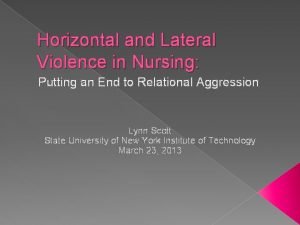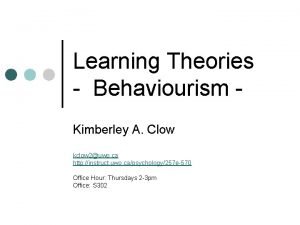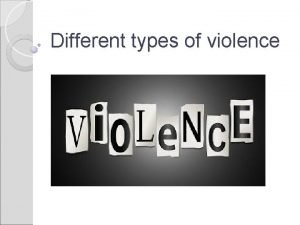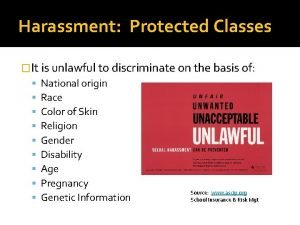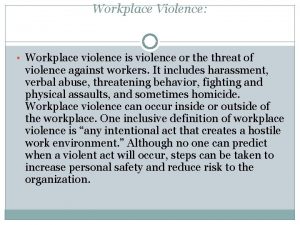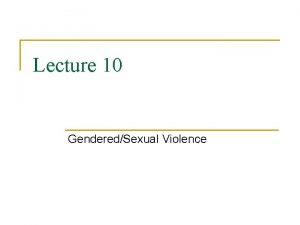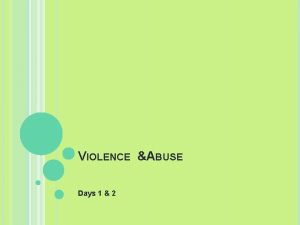Weinand M R 2010 Horizontal violence in nursing























- Slides: 23



Weinand, M. R. (2010). Horizontal violence in nursing: history, impact, and solution. JOCEPS: The Journal Of Chi Eta Phi Sorority, 54(1), 23 -26.

Why susceptibility among nurses • Antagonistic behaviors among oppressed people i. e. : women • Nursing predominately women • Antagonistic behaviors, a form of self-hate • Demonstrated in the classroom with faculty dominating student nurses. • Nurse managers and supervisors cited as frequent users of bullying culture & top down style

End Product from HV • Overwhelming sense of negativity cultivated • Aggression breeds aggression • Low morale • High turnover • Increased absence • Low productivity

Formal training in teamwork, positive feedback, conflict management and confrontation skills Reward resolution vs. identification of problems

King-Jones, M. (2011). Horizontal Violence and the Socialization of New Nurses. Creative Nursing, 17(2), 80 -86. • overt and covert nonphysical hostility, • criticism, sabotaging, undermining, infighting, scapegoat, and bickering • unkindness, discourtesy, divisiveness, and lack of cohesiveness • belittling gestures, verbal abuse, gossiping, sarcastic comments, faultfinding, devaluing comments, • disinterest and discouragement, and controlling behaviors

Knowledge is power -- a cycle of power and resistance To resolve HV, address the dynamics of power and conflict

Hahn, J. A. (2011), Managing Multiple Generations: Scenarios From the Workplace. Nursing Forum, 46(3), 119 -127. • Increased numbers of generations working together creates more opportunity for misunderstanding • Veterans, [born before 1945] • Baby Boomers, [born 1946 -1964] • Generation X, [1965 -1976] • Gen Y/Millennials [1977 -1997]



Generation Veterans <1945 Generational styles Stable Reliable Practical Loyal Baby Boomers 1946– 1964 Generation X 1965– 1976 Millennials 1977– 1997 Involvement Personal growth Optimism Mentors Think globally Techno-literacy Pragmatic Asynchronous communication Skeptical Multitasking Technologically savvy Outcome driven Determined

Kupperschmidt, B. (2006). Addressing multigenerational conflict: mutual respect and carefronting as strategy. Online Journal Of Issues In Nursing, 11(2), • Kupperschmidt argues that professional nurses must care enough about their patients, profession, colleagues, and themselves to ‘carefront’ disrespectful behavior

Carefronting, a model of communication used when professional nurses care enough about themselves and their patients to confront disrespectful behavior face-to-face


The goal is the ability to work together to provide safe patient care in an environment based upon mutual respect Kean Univ ersity Graduate s


Yvonne Bivins MSN RN Nadia Primus MSN RN

16 14 12 7 10 8 6 5 4 2 0 Associate Degree Bachelor's Degree Number of Participants Graduate Degre Pre-test Post-test Baby Boomer RNs 7 4 Generation X RNs 17 8

Yvonne Bivins MSN RN Nadia Primus MSN RN • A paired t test compared pre and post mean scores of the participants’ perceived ability to utilize Carefronting • pre-test M= 40. 75, SD=4. 15 • post-test M= 43. 08, SD=3. 08 • Highest possible score being 50 and the lowest 10 • Alpha set at p<0. 05 • There was no significant difference t(11) = -2. 17, p = 0. 053. The 95% confidence interval for the mean difference between the two means was -4. 70 to 0. 03.

Yvonne Bivins MSN RN Nadia Primus MSN RN compared Baby Boomer to Gen X mean scores on perceived ability to utilize Carefronting • No significance difference in the Baby Boomer & Generation X mean scores • pre-test t(24) =. 992, p =. 33 • post-test t(11) =. 154, p =. 88

Carefronting Techniques based on Kupperschmidt (2006) q When you called me a rookie and said I jumped to a conclusion (what was the action). I felt humiliated (your reaction). q Because it portrays me as someone in a rush (what does it look, sound or feel like). q Was it your intention to embarrass or humiliate me? (repeat what the action was, STOP! wait for a response) q In the future talk to me in private (what behavior you want to see). q Are you committed to treating me as respected colleague? (What you want them to do? ) q If there isn’t a change, I will arrange a meeting with the supervisor to discuss your actions (what is the consequence).

Take home Message Carefronting
 Horizontal violence theory
Horizontal violence theory Define lateral violence in nursing
Define lateral violence in nursing Tv violence
Tv violence Liz kelly continuum of violence
Liz kelly continuum of violence Different types of violence
Different types of violence Xxxxxx violence
Xxxxxx violence Domestic violence kink
Domestic violence kink Indicators of potential workplace violence:
Indicators of potential workplace violence: Chicken humour
Chicken humour Xxxx xx v
Xxxx xx v Workplace violence and harassment quiz answers
Workplace violence and harassment quiz answers Expressive violence
Expressive violence Dhs workplace violence
Dhs workplace violence Chapter 9 lesson 3 understanding violence
Chapter 9 lesson 3 understanding violence Ebb tide tackle
Ebb tide tackle The three r's for stopping domestic violence
The three r's for stopping domestic violence Chapter 10 section 2 protest resistance and violence
Chapter 10 section 2 protest resistance and violence How to read literature like a professor violence
How to read literature like a professor violence Framework agreement on harassment and violence at work
Framework agreement on harassment and violence at work Gandhi king and mandela what made non-violence work dbq
Gandhi king and mandela what made non-violence work dbq Domestic violence in the hispanic community
Domestic violence in the hispanic community S68r family law act
S68r family law act Antecedent passion example situation
Antecedent passion example situation Indicators of potential workplace violence
Indicators of potential workplace violence
